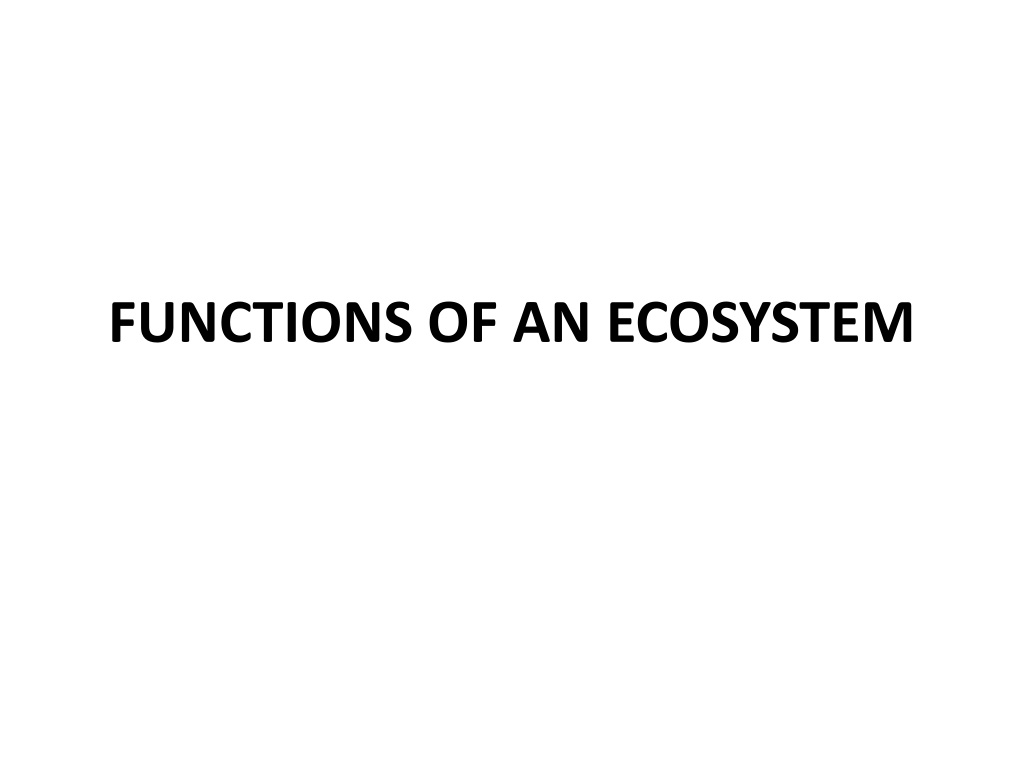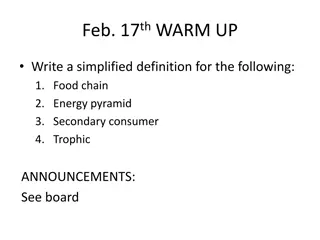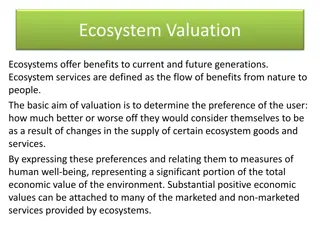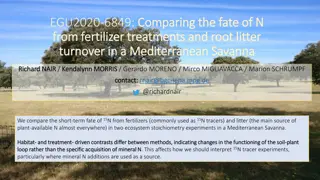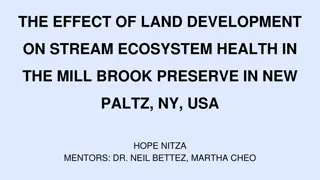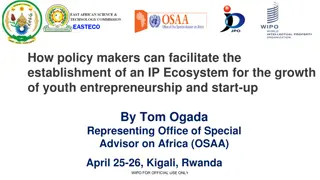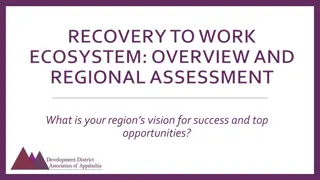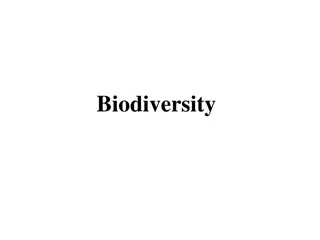Understanding the Key Functions of an Ecosystem
Ecosystem functions are vital for the survival of various components within them, with energy flow, nutrient circulation, and biogeochemical cycles playing significant roles. Energy flow starts with solar radiation and sustains producers, consumers, and decomposers, highlighting the interconnectedness of all organisms in an ecosystem.
Download Presentation

Please find below an Image/Link to download the presentation.
The content on the website is provided AS IS for your information and personal use only. It may not be sold, licensed, or shared on other websites without obtaining consent from the author. Download presentation by click this link. If you encounter any issues during the download, it is possible that the publisher has removed the file from their server.
E N D
Presentation Transcript
FUNCTIONS OF AN ECOSYSTEM Ecosystem functions mainly comprise the interactions of various components in an ecosystem They are interconnected by energy, nutrients and minerals The survival of an ecosystem depends on Flow of energy-- Non cyclic food chain Biogeochemical cycle Cyclic food chain - circulation of nutrients and minerals
Important functions of an ecosystem are Energy Primary production Secondary production Food chain Food web Trophic levels Energy flow Ecological pyramid Biogeochemical cycles
ENERGY FLOW Energy is the ability to do work Main source - the radiant energy or light energy derived from the sun Energy Trapped Producers Utilized Consumers Consumed Secondary consumer
SOURCE OF ENERGY Ecosystems - composed of a variety of abiotic components such as soil, water, atmosphere, radiation from the sun Solar radiation Soils provide nutrients, water act as home and a medium for organisms 2 cal / sq.cm./min Earth surface The atmosphere provides carbon dioxide for photosynthesis and oxygen for respiration (Solar flux or solar constant) 95-99% Lost by reflection Sunlight is necessary for photosynthesis 0.02% Energy reach earth (Plant utilize) Photosynthesis provides the energy for plant growth and metabolism and the organic food for animal life
Ecosystems - composed of producers, consumers and decomposers Producers or autotrophs - manufacture their food by photosynthesis Consumers - get their energy and nutrients by feeding directly or indirectly on producers Herbivores - consumers that eat plants for their energy and nutrients
Consumer organisms that feed on this organic matter or detritus are known as detrivores or decomposers The organic matter that is consumed by the detritivores is eventually converted back into inorganic nutrients in the soil Energy flow and energy transformation in an ecosystem obeys the law of thermodynamics
THERMODYNAMICS The first law of thermodynamics It states that energy can neither be created nor destroyed, but it can simply change in form The light energy of the sun is converted into electrical energy in the chlorophyll The electrical energy is converted into chemical energy during photosynthesis The chemical energy is transformed in to heat energy during metabolism The heat energy is transformed into mechanical energy for doing work Energy can neither created nor destroyed i.e. the energy of ecosystem is constant and thus it obeys the first law of thermo dynamics
The second law of thermodynamics It states that during energy transfer, large part of energy is degraded into heat and dissipates When energy is transferred from producers to herbivores about 90% of energy is lost as heat The change of energy from one form to another the free energy diminishes and thus it obeys the second law of thermo dynamics
Flow of energy between phyto and zooplankton Ecological efficiency Et = Pt Pt-1 Et will be equal to the amount of herbivore (Pt) divided primary productivity(Pt-1 ) in marine ecosystem ie. 20% plants to herbivores and 15-10% at higher tropic levels
ENERGY AND MATTER TRANSFER IN ECOSYSTEM The transfer of energy from one trophic level to another is called energy flow This flow of energy is always unidirectional and never returns back So, energy can be utilized once in the ecosystem and otherwise it will go as waste heat
Energy flows from one trophic level to another Green plants or other photosynthesizing organisms use light energy from the sun to manufacture carbohydrates for their own needs Chemical energy is processed in metabolism and dissipated as heat in respiration Plants convert the remaining energy to biomass The stored energy, is transferred to the second trophic level, which comprises grazing herbivores, decomposers and detrital feeders
Energy at the second trophic level - lost as heat in respiration; fraction becomes new biomass More steps between producer and final consumer, the less energy remains available In a food web there are more than four links, or five levels Energy flowing through the trophic levels is dissipated as heat The process whereby energy loses its capacity to do work is called entropy
The energy transfer between producers and herbivores is only 10% Remaining 90% is lost through faces, respiration and unused energy or heat Hence, the amount of energy available decreases from trophic level to another trophic level Short food chain - final consumers will get a large amount of energy Long food chain - final consumer will get a lesser amount of energy
TROPHIC STRUCTURE The trophic structure is an arrangement of autotrophs and succeeding such of heterotrophs is called as trophic structure in which each successive consumer level is called a tropic level Also called as feeding levels Trophic levels Autotrophs - producers synthesis their own food by themself Herbivores consumers of only plants Carnivores- consumers of only animals Omnivores consumers of both plants and animals Decomposers- Decomposers of dead and decaying matters
Each step of the food chain is called is called trophic level. Each food chain contains many trophic levels Autotrophs - Herbivores Trophic level Carnivores- Omnivores Trophic level Decomposers Trophic level Trophic level 1 2 3 4 5 Trophic level
The different feeding levels in the food chain are called trophic levels Food chains comprised of many feeding or nourishing levels and each level is called trophic level The first trophic level in the food chain is called primary producers, the second trophic level is primary consumers (herbivores) and the third level is primary carnivores Lower the number of trophic levels, higher the transfer of energy to the top level organisms in the food chain The energy transfer will be very less to the top predator, if the food chain is having more than three levels of trophic tiers
ENERGY TRANSFER- TROPHIC LEVELS Trophic level is simply a feeding level which often represented in a food chain or food web Primary producers - bottom of the trophic level; then primary consumers (herbivores), then secondary consumers (carnivores feeding on herbivores) and so on when we consider of moving up the food chain It moves from plants to herbivores to carnivores Food chain does not take into account decomposers and detritivores which make up their own trophic pathways
